The city clocks in Ruse measure the history of the settlement and bear the industrial marks of the centuries in which they were created.
The oldest clock is placed at the first railway station in Bulgaria, which was built in Ruse.
The first railway station in Bulgaria was opened in Ruse in 1866, marking the completion of the Ruse-Varna railway line. It is located in the eastern part of the city, adjacent to the Danube River, to facilitate the transfer of passengers and cargo between ships and Varna. Today, the building is the National Museum of Transport.
“The clock was probably installed during the construction of the station; it was put into operation around 1866,” says Eng. Alexander Parvanov, a member of the Ruschuk Association, and a specialist who understands the hearts of Ruse clocks and knows how to prolong their life. The mechanism was manufactured by the Voile company in the city of Bokenem, Germany. It is a typical station (platform) clock - it has a standing box in the waiting room and two dials on the platform. It is modified with self-winding, which is not currently used. The outer dials do not work.
Description: The oldest clock is placed at the first railway station in Bulgaria
A clock with two dials has been installed on the building of the first branch of the Bulgarian National Bank outside Sofia
It was built in 1896-1897, presumably, but there is no exact data on this. Now the building houses the Labor Inspectorate. The building was built in 1896, and its architect was Heinrich Meyer. The first branch of the Bulgarian National Bank outside Sofia was housed there. "The mechanism was manufactured by the Mannhard company in Munich, probably around 1895. That is also practically a station clock with two dials - the outer one facing the street, and the inner one, which is of a smaller diameter, facing the bank hall. This clock is very nice, but it was missing the inner dial (along with the gearbox and hands), and stopped, explains Parvanov. - But in 2018, we from the Ruschuk association started searching for and producing parts, installing them, and making improvements. We have been taking care of it until now. The watch is working, but we still have a few details before we hand it over to the Labor Inspectorate."
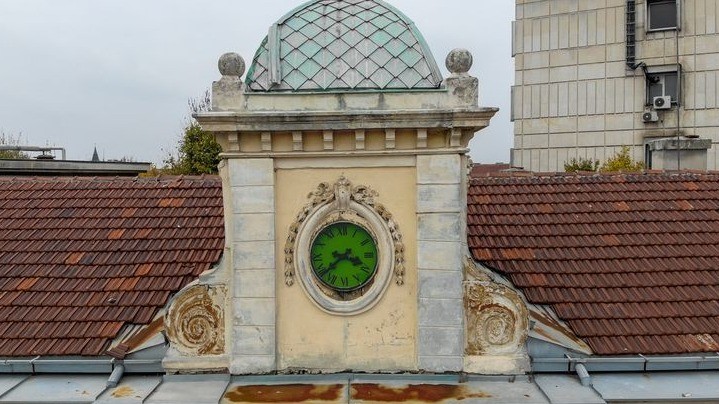
Description: The Labor Inspectorate Clock
The first private bank in Bulgaria, founded in 1881 in Ruse, also had a mechanical clock.
It is known as the joint-stock savings company "Girdap", which was situated in a building built in 1896. The building is in the city center and over the years has become a favorite meeting place for Ruse's residents. It is called by them "The Clock". There is no preserved documentation, and it is not known when the clock was installed, says Parvanov. According to him, that probably happened in the period 1896-1900. It was manufactured by the German company Bernhard Zacharia and has a large and beautiful dial.
After nationalization in 1947, the "Girdap" building changed its purpose, but the clock remains part of it, to remind us today of the time when Ruse was the financial heart of Bulgaria.
The clock does not have a bell; it is artificially sounded with private funds and has been maintained free of charge since 2017. Its gong can be heard every hour, and since 2018, it has been playing melodies related to the respective holiday on Christmas and May 24. The last maintenance of the clock was carried out in November 2022 by the District Administration.
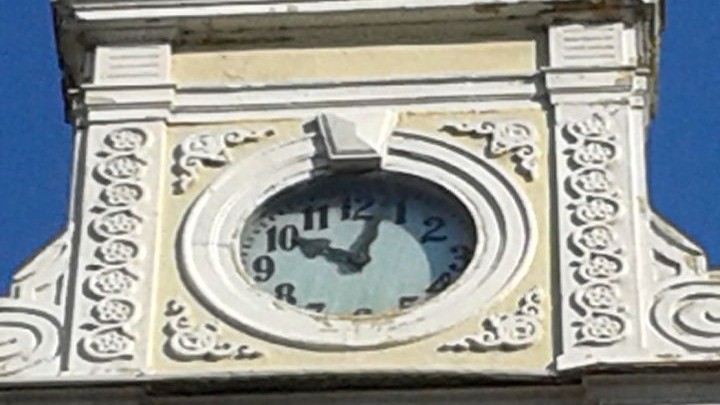
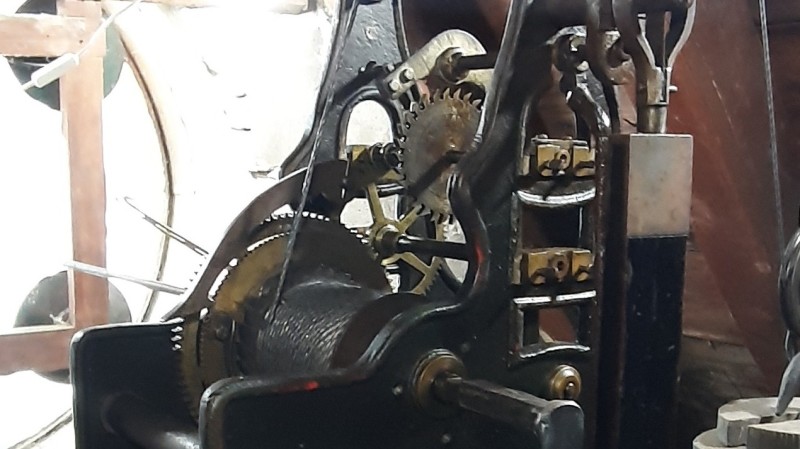
Description: The clock of the first private bank in Bulgaria, known as the Girdap company
The largest and most representative is the clock of the country's first Chamber of Commerce and Industry, which was established in Ruse.
Today, the building, located on Batenberg Square, houses the Regional Library "Lyuben Karavelov". The building dates back to 1914. At first, it was intended for the country's first Chamber of Commerce and Industry. However, at that time, there was still no clock, although a place for it was provided. That was the case until 1923, when the Chamber of Commerce delivered a mechanism from the Voile company. "It was only then that a clock was installed," explains Parvanov, who is the author of the only study and description of the history of the delivery and installation of this clock. "The mechanism has been preserved in its authentic form; it is massive, with bronze gears mounted in beautifully cast consoles, and an external bell. There are two separate pulleys for the clock and the bell. It rings once every half hour, and its corresponding number of times per full hour. The pendulum is elegant, with a wooden arm and cast with the characteristic embossed emblem of the company. The dial is 140 cm in diameter, driven by metal rods of about 5 m. Today, some models produced by Johann Voyle's company can be seen in the clock museum in the German city of Böblingen, where the company was founded. Many of Voyle's clocks have been delivered to Bulgaria. Two of them are located in Ruse - one in the library tower, the other in the hall of the country's first railway station, now a Museum of Transport.
In 2014, at the initiative of Alexander Parvanov, with personal labor and funds from several former students of the "Hristo Botev" school, with the full cooperation of the library director, Teodora Evtimova, the clock was thoroughly cleaned, assembled, and restored. The Ruse clockmaker, Bohos Sarkisyan, was hired. The dial, the connection with the bell, and the lighting were restored, as described in his book "City Clocks" by its author, Alexander Parvanov. Since 2014, it has been constantly measuring time, and in 2020, the library management thoroughly renovated the room with the clock. Now it is a wonderful place to visit. The clock tower is part of the tourist tour offered by the Regional Library "L. Karavelov".
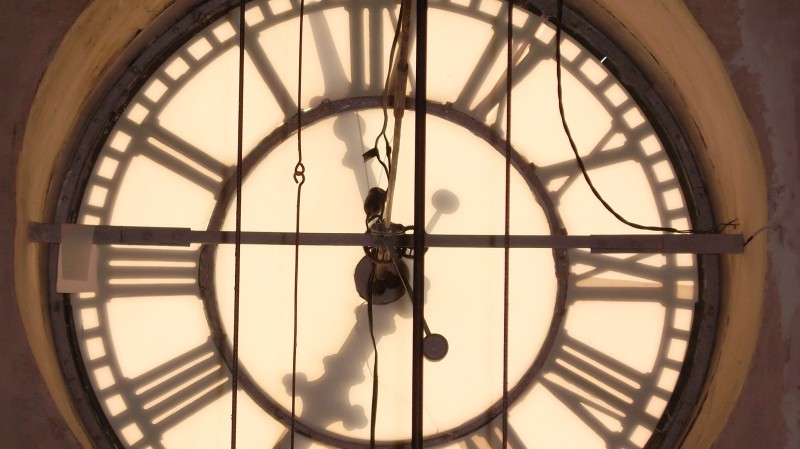
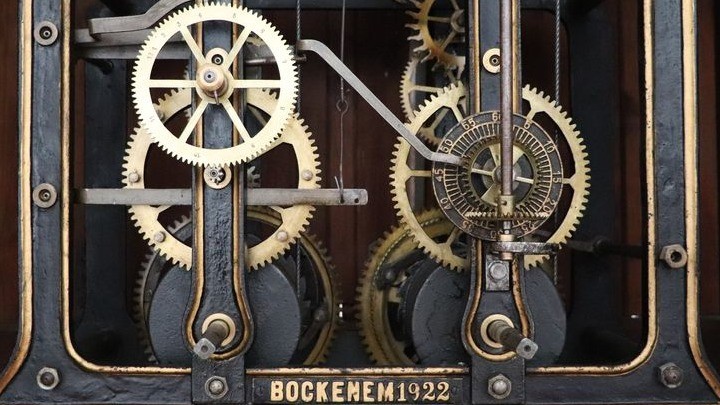
Description: The clock of the Regional Library "L. Karavelov" and its mechanism
The clock at the Central Railway Station in Ruse, which is the only three-story railway station in Bulgaria
The building was built according to the design of Ruse's architect, Pinpirev, who also designed the Sofia Central Station. It started operating in 1955 and has since been one of the symbols of the city. The clock was installed above the main entrance of the station. In 2007, it was repaired and restored by the master watchmaker Alexander Abadzhiev.
The railway station, together with the Danube Bridge and the glass kiosk in the city center, became one of the emblems of Ruse in the 1950s and 1960s.
Description: The oldest clock is placed at the first railway station in Bulgaria
The clocks of the Municipality and District buildings
The other significant clocks in Ruse are located on the facade of the Ruse Municipality and Regional Administration buildings. "They are part of an electromechanical system, including a common timer and dials in the corridors of all floors and on the facade of the main entrance," explains Alexander Parvanov. "After the main device failed, a new one had to be made, and now only the two clocks at the entrance to the building are working."
Each clock on the public buildings now enriches the cultural, economic, and historical image of Ruse. It reminds us of the time when Ruse was the financial center of Bulgaria. The hands count down political events and social changes, and turn the mechanisms into symbols of the European development of the city.